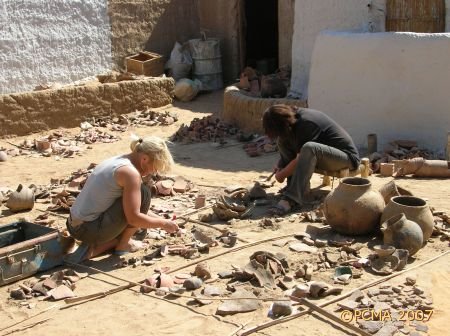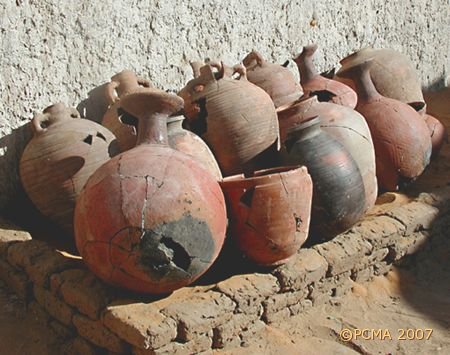Old Dongola: The Monastery (Sudan)
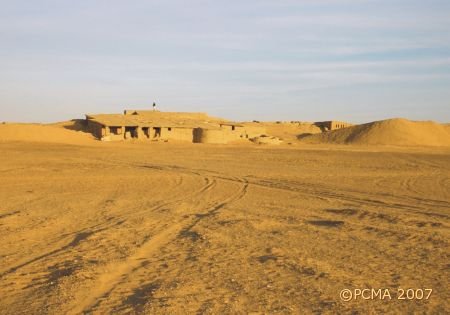
The Old Dongola Monastery expedition took to the field twice this year, for the first time from 14 December 2005 to 27 January 2006 (41st season) and from 15 November to 22 December 2006 (42nd season). The year was also momentous in that a smooth change of guard occurred. Dr. Stefan Jakobielski retired at mid-year, handing over the direction of the mission to his colleague from the Polish Academy of Sciences, Dr. Małgorzata Martens-Czarnecka, but continuing as a valued and irreplaceable member of the expedition.
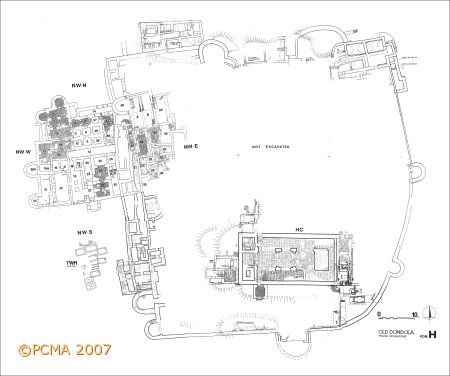
The project continued exploration on several sites where work has been ongoing for the past few seasons. One of these sites is adjacent to the eastern side of the monastery circuit wall, more or less opposite the extra muros Southwestern Annex excavated in previous years. Indeed a transversal corridor-passage SW.12 gives from the southwestern corner of a newly discovered courtyard (SW-E.14), leading through a vaulted entrance to a staircase (SW.7) that opens onto the upper floor of the Annex. The said courtyard extends along the western circuit wall of the monastery. Structures have been traced to the south and north of this courtyard and were explored in the course of these two seasons. The small building to the south (SW-E.13 and 13A) consisted of two rectangular vaulted rooms, built on top of a layer of rubble that must have come from the destruction of the circuit wall. The walls here were exceedingly thick (0.50m thick) and the rooms 3.10m high. A single entrance led down a few steps from the courtyard and an arcade joined the first room to the second one. The floor was of tamped clay (four occupational levels were traced) and there was evidence on the walls of soot and various sockets for mounting (wooden?) shelves and benches.
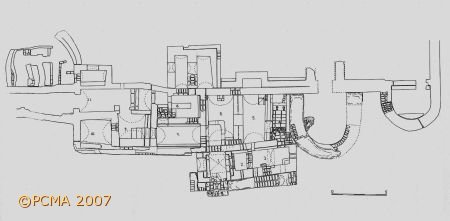
The structure to the north of this courtyard (SW-E.16) was just as obviously of some sort of utilitarian function. It was rebuilt heavily throughout its existence and in the latest phase consisted of four narrow (0.50-1 m) compartments connected by a transversal corridor. The southernmost compartment, which was divided in two, yielded an interesting assemblage of pottery vessels and other ceramic elements, including pipes of all kinds and two terracotta toilets (one in excellent condition). Presumably the dismantled toilet facilities were discarded in the last phase of the existence of the Monastery, i.e., in the 14th century.
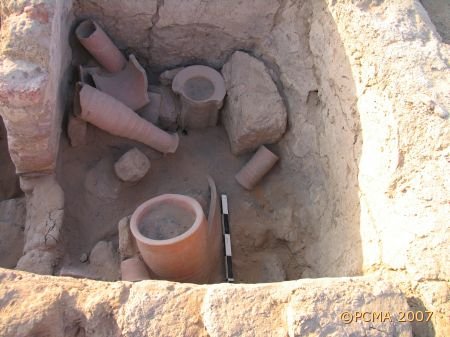
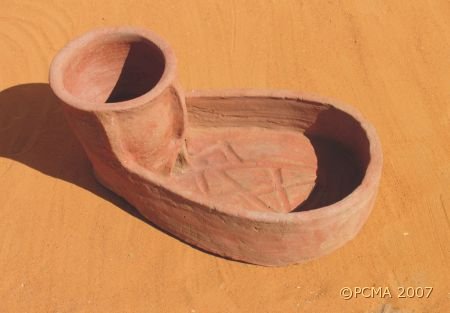
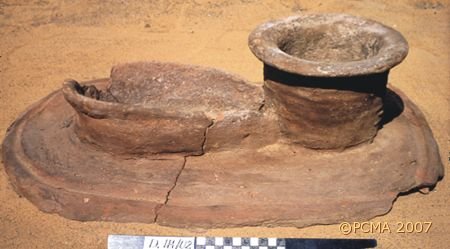
The most recent season was also devoted to uncovering the main western gate in the monastery circuit wall and to testing its foundations and original level of the monastery courtyard in this area. Further clearing and testing were also carried out in rooms 26 and 30 of the Northwestern Annex. The results clarified question concerning the inner layout of the building and the nature of changes occurring in successive phases. Testing by the west wall in Room 30 brought to light the level from which the monastery circuit wall was built. Relevant pottery finds confirmed the dating of this event in the 7th-8th century. It is now clear that before Archbishop Georgios’ rebuilding project, in the effect of which the chapels in chambers 29 and 31 were constructed, a courtyard had existed in this area with a doorway opening to the south.
The other area of major focus for the expedition is the Monastery Church (HC), where excavations are supervised by Daniel Gazda.
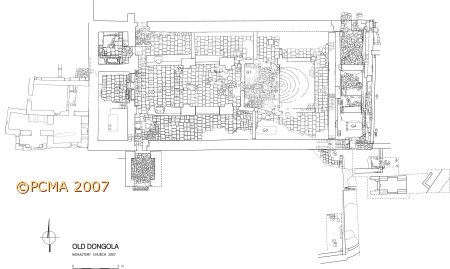
In the course of the two recent seasons, the entire church including its southern and northern aisles was cleared. The entrance from the narthex to the nave proved to be framed by murals, remains of which could be interpreted as a stylized palm in red and yellow supporting an architrave decorated with a meander. The northwestern chamber (3.20 x 3.20 m) proved to have various furnishings such as a high mastaba evidently intended as a bed, a cupboard with two arched openings that served also as a table and a vaulted cellar 1.20m deep. There were also low narrow benches by the north and west walls and windows, later blocked, 0.60m wide. It is tempting to interpret this room as the quarters of a monk-sacristan.
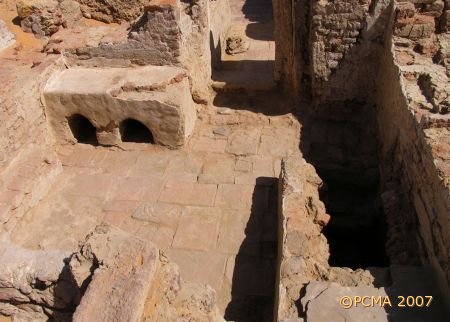
Clearing of the southern aisle in the eastern end and along the eastern façade revealed the original southeastern corner of the church, which was dismantled down to the ground, like most of the south wall. The eastern end of the church had been rebuilt heavily, but the original northeastern corner was located. The building was apparently shortened from the eastern end for reasons as yet unfathomed. It is clear, however, that some intensive building activities took place here.
The northern and southern entrances to the church were discovered and examined. The southern doorway with well-preserved threshold gave onto a brick-paved courtyard which extended all the way to the circuit wall. A graveyard extends southeast of the church; two cruciform mastaba-like superstructures (G.5 and G.6) were investigated, the latter of the two reaching a stupendous size of 4 by 1.90m. Both tombs can be dated to the 7th century. In the 8th or 9th century the burial ground was forgotten and started being used as a rubbish dump.
Four rectangular grave pits located inside the church were also examined. G.1, G.2 were located in the presbytery and G.3 in the eastern end of the southern aisle. All contained males of roughly middle or elderly age, but the middle-aged male deposited in G.3, the only of the three to have a chamber with gable brick roof and shaft on the west side, is believed to be Bishop Joseph (d. AD 668), the presumed founder of the monastery. The grave predates the first rebuilding of the church. The fourth grave, G.4, a vaulted chamber with shaft on the west, contained two females (aged 40-55 and 25-30) and a small girl of 6-8 years. It was located already beyond the relocated east wall of the church.
A basin possibly for holy water was uncovered by the northern church entrance, which led into a kind of vestibule paved with terracotta slabs joining the church with the central monastic building (CB), currently constituting a small kom to the north of the church.
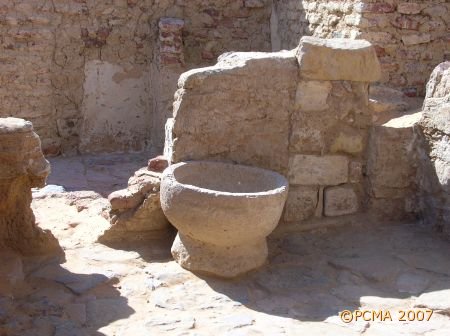
The walls of this structure are covered with murals according to expectations: an archangel depicted en face on the north wall of the vestibule, a row of figures on the east wall, the Virgin Mary on the south.
Archaeological work was paralleled throughout the season by mural preservation and conservation activities in the Monastery Church and also in the Northwestern and Southwestern Annexes. The outside west wall of the church was built up using original bricks but in a bond and using mortar that is markedly different from the ancient ones for the purpose of separating the newly restored parts. Roofing was introduced where essential and screening walls were erected in front of several murals left in situ. In the winter season, new roof covering was introduced as part of regular maintenance activities. All entrances were blocked at the close of the season as protection against trespassers.
